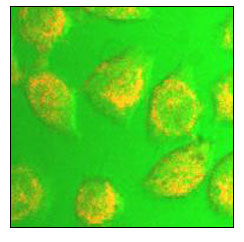BUFFALO, N.Y., Sept. 13 -- Efficient and highly scalable new chemical synthesis methods developed at the University at Buffalo (UB) Institute for Lasers, Photonics and Biophotonics have the potential to revolutionize the production of quantum dots for bioimaging and photovoltaic applications.
Quantum dots are tiny semiconductor particles generally no larger than 10 nanometers that can be made to fluoresce in different colors, depending on their size. Scientists are interested in quantum dots because they last much longer than conventional dyes used to tag molecules, which usually stop emitting light in seconds. Quantum dots also are of great interest for energy applications because they can produce electrons when they absorb light, making possible extremely efficient solar-energy devices.

A confocal microscope image shows quantum dots, developed at the University at Buffalo, uptaken by cancer cells. (Photo courtesy University at Buffalo)
Both fabrication methods developed by the UB researchers involve using a single container, or "pot," and take just a few hours to prepare.
The UB scientists report that one of their rapid-solution synthesis methods enabled them to prepare robust, water-dispersible quantum dots for bioimaging, while the other one allowed them to prepare organically soluble quantum dots ready to be sequestered into a polymer host.
A patent has been filed on the methods, which were described last month in papers in the Journal of the American Chemical Society and Applied Physics Letters.
The new synthesis methods are truly scalable and can be used to produce large quantities of quantum dots, according to A co-author of the papers, Paras N. Prasad, PhD, a chemistry professor and executive director of the Institute for Lasers, Photonics and Biophotonics.
"This fast-reaction chemistry will allow us to exploit the true potential of quantum dots, whether it be for delivery into human cells for imaging biological processes in unprecedented detail or for the development of far more efficient devices for solar conversion," he said.
Nontoxic properties
On Aug. 17, the UB researchers reported what is believed to be the first successful demonstration of so-called III-V semiconductor quantum dots as luminescence probes for bioimaging that appear to be nontoxic. III-V, and other such classifications, refer to the position on the periodic table of the elements that make up semiconductors.
Until now, only II-VI quantum dots have been produced for these applications. However, they are highly toxic to humans. Composed of indium phosphide, the nanocrystals developed at UB demonstrate luminescence efficiencies comparable to other quantum dots, but they also emit light in longer wavelengths in the red region of the spectrum.
"This is a key advantage, because red-light emission means these quantum dots will be capable of imaging processes deeper in the body than commercially available quantum dots, comprised of cadmium selenide, which emit mostly in the lower wavelength range," said Prasad.
Like those cadmium selenide quantum dots, the nanocrystals also exhibit two-photon excitation, absorbing two photons of light simultaneously, which is necessary for high-contrast imaging.
The UB group's quantum dots are composed of an indium phosphide core surrounded by a zinc selenide shell to protect the surface. An organic group then is attached to this shell, as well as a targeting group, in this case, folic acid. Folate receptors are targeted commonly by drugs in diseases such as cancers of the breast, ovary, prostate and colon.
In their experiments, UB researchers showed that the quantum dot system recognized the folate receptor and then penetrated the cell membrane, Prasad said.
The entire system is water dispersible, which is critical, he said, if quantum dots are to be widely used for bioimaging.
The other scalable chemical fabrication procedure developed by the UB researchers allowed them to prepare quantum dot-polymer nanocomposites that absorb photons in the infrared region.
Infrared-friendly
The work was described in the paper, "Efficient photoconductive devices at infrared wavelengths using quantum dot-polymer nanocomposites," published online Aug. 11 in Applied Physics Letters (APL).
"Current solar cells act only in the green region, thus capturing only a fraction of the available light energy," Prasad said. "By contrast, we have shown that these lead selenide quantum dots can absorb in the infrared, allowing for the development of photovoltaic cells that can efficiently convert many times more light to usable energy than can current solar cells."
In addition to broadening the applications for solar energy in general, the UB research is likely to have applications to nighttime imaging systems used by the military that must absorb and emit light in the infrared.
"Because of the efficient photon harvesting ability of quantum dots, in the immediate future we will be able to incorporate a few different types of them simultaneously into a plastic host material so that an efficient and broadband active solar device is possible," said Yudhisthira Sahoo, PhD, a research assistant professor in the UB Department of Chemistry and co-author of the APL paper.
Co-authors with Prasad on the paper in the Journal of the American Chemical Society are Dhruba J. Bharali, PhD, and Derrick W. Lucey, PhD, postdoctoral associates, and Haridas E. Pudavar, PhD, senior research scientist, all of the UB chemistry department, and Harishankar Jayakumar, a graduate student in the electrical engineering department.
The research was supported by a Defense University Research Initiative in Nanotechnology grant from the Air Force Office of Scientific Research and by the John R. Oishei Foundation, as well as by UB's New York State Center of Excellence in Bioinformatics and Life Sciences.
Co-authors with Prasad and Sahoo on the APL paper are K. Roy Choudhury, a graduate student in the UB physics department, and T.Y. Ohulshanskyy, PhD, a senior research scientist in the UB chemistry department. The research was supported by the DURINT grant and by the National Science Foundation.
For more information, visit: www.buffalo.edu